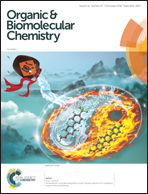Tetraphenylethylene-based glycoclusters with aggregation-induced emission (AIE) properties as high-affinity ligands of bacterial lectins†
Abstract
Tetraphenylethylene (TPE) is fluorescent through aggregation induced emission (AIE) in water. Herein, TPE was used as the core of glycoclusters that target the bacterial lectins LecA and LecB of Pseudomonas aeruginosa. Synthesis of these TPE-based glycoclusters was accomplished by using azide–alkyne “click” chemistry. The AIE properties of the resulting glycoclusters could be readily verified, but imaging could not be pursued due to the overlap of the fluorescence signals from cells and bacteria. Nonetheless, the glycoclusters displayed nanomolar affinities toward LecA and LecB. Further evaluation in a cell-based anti-adhesive assay highlighted a limited decrease in adhesion (20%) for the fucosylated glycocluster. This confirmed that these TPE-based glycoclusters are indeed LecA and LecB high-affinity ligands. Nevertheless, the hypotheses involving their application in imaging or anti-adhesive therapy could not be verified.

- This article is part of the themed collection: Chemical Biology in OBC


 Please wait while we load your content...
Please wait while we load your content...